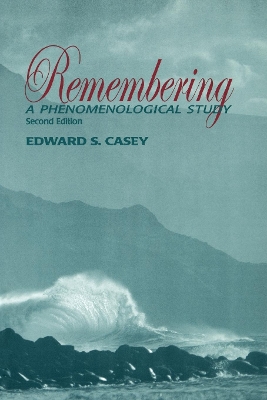Studies in Continental Thought
6 total works
This rich intervention in the current discourse among scholars in the humanities and social sciences asserts the pervasiveness of place in constructing culture and identity.
Remembering
A Phenomenological Study
Second Edition
Edward S. Casey
A pioneering investigation of the multiple ways of remembering and the difference that memory makes in our daily lives.
A Choice Outstanding Academic Book
"An excellent book that provides an in-depth phenomenological and philosophical study of memory." -Choice
". . . a stunning revelation of the pervasiveness of memory in our lives." -Contemporary Psychology
"[Remembering] presents a study of remembering that is fondly attentive to its rich diversity, its intricacy of structure and detail, and its wide-ranging efficacy in our everyday, life-world experience. . . . genuinely pioneering, it ranges far beyond what established traditions in philosophy and psychology have generally taken the functions and especially the limits of memory to be." -The Humanistic Psychologist
Edward S. Casey provides a thorough description of the varieties of human memory, including recognizing and reminding, reminiscing and commemorating, body memory and place memory. The preface to the new edition extends the scope of the original text to include issues of collective memory, forgetting, and traumatic memory, and aligns this book with Casey's newest work on place and space. This ambitious study demonstrates that nothing in our lives is unaffected by remembering.
Studies in Continental Thought-John Sallis, general editor
Contents
Preface to the Second Edition
Introduction Remembering Forgotten: The Amnesia of Anamnesis
Part One: Keeping Memory in Mind
First Forays
Eidetic Features
Remembering as Intentional: Act Phase
Remembering as Intentional: Object Phase
Part Two: Mnemonic Modes
Prologue
Reminding
Reminiscing
Recognizing
Coda
Part Three: Pursuing Memory beyond Mind
Prologue
Body Memory
Place Memory
Commemoration
Coda
Part Four: Remembering Re-membered
The Thick Autonomy of Memory
Freedom in Remembering
Imagining
A Phenomenological Study
Second Edition
Edward S. Casey
A classic firsthand account of the lived character of imaginative experience.
"This scrupulous, lucid study is destined to become a touchstone for all future writings on imagination." —Library Journal
"Casey's work is doubly valuable—for its major substantive contribution to our understanding of a significant mental activity, as well as for its exemplary presentation of the method of phenomenological analysis." —Contemporary Psychology
". . . an important addition to phenomenological philosophy and to the humanities generally." —Choice
". . . deliberately and consistently phenomenological, oriented throughout to the basically intentional character of experience and disciplined by the requirement of proceeding by way of concrete description. . . . [Imagining] is an exceptionally well-written work." —International Philosophical Quarterly
Drawing on his own experiences of imagining, Edward S. Casey describes the essential forms that imagination assumes in everyday life. In a detailed analysis of the fundamental features of all imaginative experience, Casey shows imagining to be eidetically distinct from perceiving and defines it as a radically autonomous act, involving a characteristic freedom of mind. A new preface places Imagining within the context of current issues in philosophy and psychology.
[use one Casey bio for both Imagining and Remembering]
Edward S. Casey is Professor of Philosophy at the State University of New York at Stony Brook. He is author of Getting Back into Place: Toward a Renewed Understanding of the Place-World (Indiana University Press) and The Fate of Place: A Philosophical History.
Studies in Continental Thought—John Sallis, general editor
Contents
Preface to the Second Edition
Introduction The Problematic Place of Imagination
Part One: Preliminary Portrait
Examples and First Approximations
Imagining as Intentional
Part Two Detailed Descriptions
Spontaneity and Controlledness
Self-Containedness and Self-Evidence
Indeterminacy and Pure Possibility
Part Three: Phenomenological Comparisons
Imagining and Perceiving: Continuities
Imagining and Perceiving: Discontinuities
Part Four: The Autonomy of Imagining
The Nature of Imaginative Autonomy
The Significance of Imaginative Autonomy
From one of continental philosophy's most distinctive voices comes a creative contribution to spatial studies, environmental philosophy, and phenomenology. Edward S. Casey identifies how important edges are to us, not only in terms of how we perceive our world, but in our cognitive, artistic, and sociopolitical attentions to it. We live in a world that is constantly on edge, yet edges as such are rarely explored. Casey systematically describes the major and minor edges that configure the human and other-than-human realms, including our everyday experience. He also explores edges in high- stakes situations, such as those that emerge in natural disasters, moments of political and economic upheaval, and encroaching climate change. Casey's work enables a more lucid understanding of the edge-world that is a necessary part of living in a shared global environment.
Remembering
A Phenomenological Study
Second Edition
Edward S. Casey
A pioneering investigation of the multiple ways of remembering and the difference that memory makes in our daily lives.
A Choice Outstanding Academic Book
"An excellent book that provides an in-depth phenomenological and philosophical study of memory." -Choice
". . . a stunning revelation of the pervasiveness of memory in our lives." -Contemporary Psychology
"[Remembering] presents a study of remembering that is fondly attentive to its rich diversity, its intricacy of structure and detail, and its wide-ranging efficacy in our everyday, life-world experience. . . . genuinely pioneering, it ranges far beyond what established traditions in philosophy and psychology have generally taken the functions and especially the limits of memory to be." -The Humanistic Psychologist
Edward S. Casey provides a thorough description of the varieties of human memory, including recognizing and reminding, reminiscing and commemorating, body memory and place memory. The preface to the new edition extends the scope of the original text to include issues of collective memory, forgetting, and traumatic memory, and aligns this book with Casey's newest work on place and space. This ambitious study demonstrates that nothing in our lives is unaffected by remembering.
Studies in Continental Thought-John Sallis, general editor
Contents
Preface to the Second Edition
Introduction Remembering Forgotten: The Amnesia of Anamnesis
Part One: Keeping Memory in Mind
First Forays
Eidetic Features
Remembering as Intentional: Act Phase
Remembering as Intentional: Object Phase
Part Two: Mnemonic Modes
Prologue
Reminding
Reminiscing
Recognizing
Coda
Part Three: Pursuing Memory beyond Mind
Prologue
Body Memory
Place Memory
Commemoration
Coda
Part Four: Remembering Re-membered
The Thick Autonomy of Memory
Freedom in Remembering





